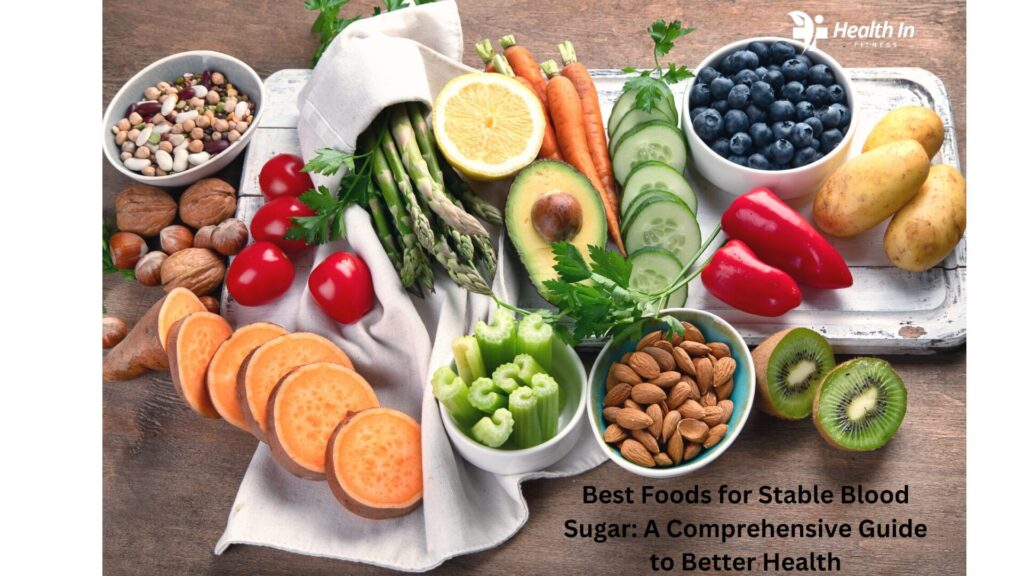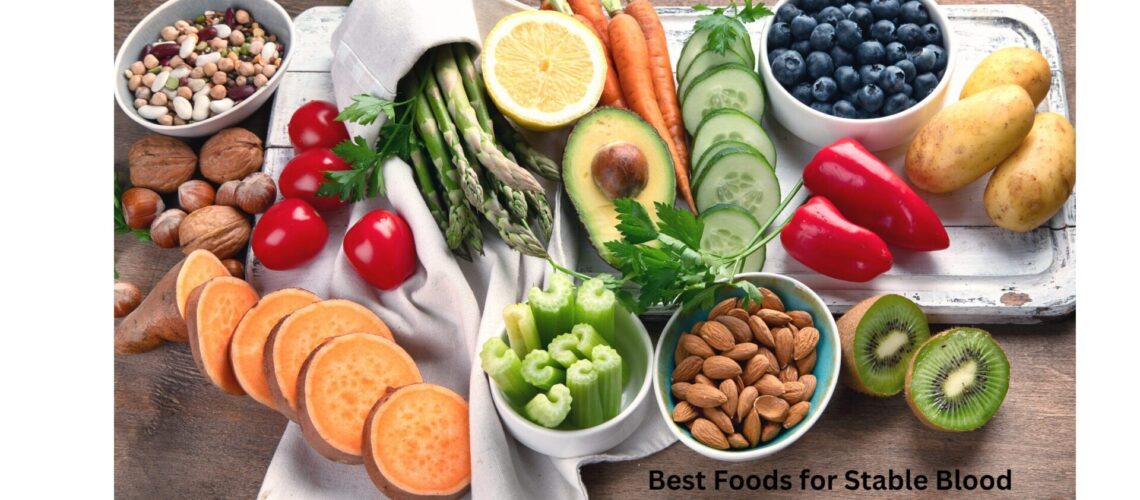
Maintaining stable blood sugar levels is essential for overall health, particularly for individuals with diabetes, prediabetes, or insulin resistance. Consistently high blood sugar can lead to a range of health issues, including heart disease, nerve damage, and kidney problems. However, stable blood sugar levels can help improve energy, mood, and reduce the risk of long-term complications. One of the most powerful ways to regulate blood sugar naturally is through diet. In this guide, we will explore the best foods for stable blood sugar, offering in-depth insights into how these foods work, their health benefits, and practical tips for incorporating them into your daily meals.
This article will cover various food groups, including vegetables, proteins, whole grains, and healthy fats, and how they contribute to stable blood sugar. We will also discuss key nutrients that help regulate blood sugar levels and highlight some practical strategies for maintaining healthy glucose levels naturally.
Understanding Blood Sugar and Its Importance
Before diving into the best foods for stable blood sugar, it’s important to understand what blood sugar is and why it matters. Blood sugar, or glucose, is the body’s main source of energy. It comes from the carbohydrates in the food we eat and is distributed to cells through the bloodstream. Insulin, a hormone produced by the pancreas, helps transport glucose from the blood into the cells for energy.
For most people, blood sugar levels fluctuate throughout the day, rising after meals and returning to normal levels during periods of fasting. However, consistently high blood sugar (hyperglycemia) can result from insufficient insulin production or the body’s inability to use insulin properly (insulin resistance). This condition, if left unmanaged, can lead to type 2 diabetes.
Maintaining stable blood sugar levels means avoiding large spikes and crashes, keeping glucose levels within a healthy range throughout the day. The foods you eat play a crucial role in this, as certain nutrients and food types can help regulate how quickly sugar enters your bloodstream.
Best Foods for Stable Blood Sugar
The key to stable blood sugar is choosing nutrient-dense, fiber-rich foods that are low in simple carbohydrates and high in vitamins, minerals, and healthy fats. Let’s explore the best foods for stable blood sugar in detail, breaking them down into specific food groups.
1. Non-Starchy Vegetables
Non-starchy vegetables are among the best foods for stable blood sugar because they are low in carbohydrates and high in fiber, vitamins, and minerals. Fiber helps slow down the absorption of sugar into the bloodstream, preventing spikes in blood sugar levels after meals.
Examples of non-starchy vegetables include:
- Leafy greens such as spinach, kale, and arugula
- Cruciferous vegetables like broccoli, cauliflower, and Brussels sprouts
- Bell peppers, zucchini, and cucumbers
- Green beans, asparagus, and celery
These vegetables provide essential nutrients without causing significant increases in blood sugar. They are also low in calories, making them ideal for weight management, which is crucial for maintaining stable blood sugar levels.
2. Healthy Fats
Healthy fats play an important role in regulating blood sugar by slowing the digestion of carbohydrates and promoting satiety, which helps prevent overeating. They also support heart health, which is particularly important for people with diabetes or insulin resistance.
Sources of healthy fats include:
- Avocados: Rich in monounsaturated fats, avocados can help improve insulin sensitivity and reduce blood sugar spikes after meals.
- Olive oil: Extra virgin olive oil is packed with healthy fats and antioxidants that reduce inflammation and improve blood sugar control.
- Nuts and seeds: Almonds, walnuts, chia seeds, and flaxseeds are great sources of omega-3 fatty acids, which have been shown to improve insulin sensitivity.
- Fatty fish: Salmon, mackerel, and sardines are high in omega-3 fatty acids, which not only benefit heart health but also help regulate blood sugar.
Adding healthy fats to your meals can make them more satisfying while supporting stable blood sugar levels.
3. Lean Proteins
Protein is essential for blood sugar management because it has little to no effect on blood glucose levels and helps regulate the release of insulin. Including lean sources of protein in your diet can help keep blood sugar levels stable by slowing down the digestion of carbohydrates and promoting feelings of fullness.
Great sources of lean protein include:
- Chicken and turkey (skinless)
- Eggs: Eggs are high in protein and contain virtually no carbohydrates, making them ideal for blood sugar control.
- Fish: As mentioned earlier, fatty fish like salmon are excellent for blood sugar regulation, but other fish like cod and tilapia are also good options.
- Greek yogurt: Unsweetened Greek yogurt is high in protein and low in carbohydrates, making it a great snack or breakfast option.
- Tofu and tempeh: These plant-based protein sources are low in carbohydrates and high in protein, making them excellent for maintaining stable blood sugar levels.
4. Whole Grains
Whole grains are a better option than refined grains for blood sugar management because they contain more fiber, which slows down the digestion of carbohydrates and prevents blood sugar spikes. Unlike refined grains, whole grains are not stripped of their nutrient-rich outer layer, which means they retain more fiber, vitamins, and minerals.
Examples of whole grains that support stable blood sugar include:
- Quinoa: Quinoa is a high-protein grain that contains all nine essential amino acids. Its fiber content helps prevent blood sugar spikes.
- Oats: Steel-cut or rolled oats are rich in soluble fiber, which helps slow the absorption of glucose into the bloodstream.
- Barley: Barley is another whole grain high in soluble fiber and has been shown to reduce blood sugar levels after meals.
- Brown rice: Brown rice contains more fiber and nutrients than white rice, making it a better choice for blood sugar control.
- Buckwheat: Despite its name, buckwheat is gluten-free and rich in fiber and magnesium, which are beneficial for managing blood sugar.
Opting for whole grains over refined grains (such as white bread or pasta) can significantly improve blood sugar control and provide sustained energy throughout the day.
5. Legumes
Legumes, including beans, lentils, and chickpeas, are excellent sources of plant-based protein and fiber, both of which contribute to stable blood sugar. They are low on the glycemic index, meaning they have a minimal impact on blood sugar levels and are digested slowly.
Popular legumes to include in your diet are:
- Black beans
- Lentils
- Chickpeas
- Kidney beans
- Pinto beans
Legumes are also rich in important nutrients like magnesium, which has been shown to improve insulin sensitivity and reduce the risk of type 2 diabetes.
6. Low-Sugar Fruits
While fruits contain natural sugars, some fruits are lower in sugar and higher in fiber, making them great choices for maintaining stable blood sugar levels. These low-sugar fruits help satisfy your sweet tooth without causing significant spikes in blood glucose.
Best low-sugar fruits for stable blood sugar include:
- Berries: Strawberries, blueberries, raspberries, and blackberries are high in fiber and low in sugar, making them excellent for blood sugar control.
- Apples: Apples are rich in fiber, particularly when eaten with the skin, and have a low glycemic index.
- Pears: Like apples, pears are high in fiber and can help regulate blood sugar when eaten in moderation.
- Grapefruit: This citrus fruit is low in sugar and has been shown to improve insulin sensitivity.
By choosing fruits that are lower in sugar and higher in fiber, you can enjoy their natural sweetness while keeping your blood sugar in check.
7. Fermented Foods
Fermented foods are rich in probiotics, which promote gut health and may help improve blood sugar regulation. Studies have shown that a healthy gut microbiome can enhance insulin sensitivity and reduce inflammation, both of which are key factors in managing blood sugar levels.
Examples of fermented foods that support stable blood sugar include:
- Kefir
- Sauerkraut
- Kimchi
- Tempeh
- Miso
Adding fermented foods to your diet can support your gut health and provide an additional layer of support for blood sugar control.
Nutrients That Help Regulate Blood Sugar
In addition to specific foods, certain nutrients play a critical role in maintaining stable blood sugar levels. Let’s take a look at some key nutrients and how they help regulate blood sugar.
1. Fiber
Fiber, particularly soluble fiber, is one of the most important nutrients for blood sugar control. It slows down the digestion of carbohydrates and reduces the rate at which sugar enters the bloodstream. Consuming a diet rich in fiber not only helps maintain stable blood sugar but also promotes overall digestive health.
Foods high in fiber include:
- Whole grains
- Legumes
- Vegetables
- Fruits (especially those with edible skins, like apples and pears)
2. Magnesium
Magnesium plays an essential role in regulating insulin and glucose metabolism. Research has shown that individuals with low magnesium levels are at a higher risk of developing insulin resistance and type 2 diabetes. Including magnesium-rich foods in your diet can help improve insulin sensitivity and support stable blood sugar levels.
Magnesium-rich foods include:
- Leafy green vegetables (spinach, Swiss chard)
- Almonds and cashews
- Pumpkin seeds
- Black beans
- Avocados
3. Chromium
Chromium is a trace mineral that enhances insulin’s action, improving glucose tolerance and helping to regulate blood sugar. While chromium deficiency is rare, getting enough of this mineral through diet can be beneficial for blood sugar management.
Sources of chromium include:
- Broccoli
- Grapes
- Turkey
- Whole grains
- Potatoes
Practical Tips for Maintaining Stable Blood Sugar Levels
Incorporating the best foods for stable blood sugar into your diet is crucial, but it’s also important to adopt some practical strategies to maintain consistent glucose levels throughout the day.
1. Eat Balanced Meals
Each meal should contain a balance of protein, healthy fats, and fiber-rich carbohydrates to help keep your blood sugar levels stable. Avoid meals that are high in refined carbs or sugary foods, which can cause rapid spikes and crashes in blood sugar.
2. Eat Smaller, More Frequent Meals
Instead of eating three large meals a day, consider eating smaller, more frequent meals or snacks. This approach can help prevent blood sugar spikes and keep your energy levels stable throughout the day.
3. Monitor Portion Sizes
Even healthy foods can raise blood sugar if eaten in large quantities. Be mindful of portion sizes, especially when it comes to carbohydrate-rich foods like grains, fruits, and legumes. Using a portion control plate or measuring cups can help ensure you’re eating the right amounts for blood sugar control.
4. Avoid Sugary Drinks
Sugary beverages like soda, fruit juice, and energy drinks can cause rapid spikes in blood sugar. Stick to water, unsweetened tea, or beverages with no added sugar to avoid unnecessary blood sugar fluctuations.
Conclusion: The Best Foods for Stable Blood Sugar
Maintaining stable blood sugar levels is essential for long-term health, and the foods you eat play a crucial role in achieving that goal. By focusing on whole, nutrient-dense foods such as non-starchy vegetables, lean proteins, healthy fats, whole grains, and low-sugar fruits, you can support stable blood sugar levels naturally. Incorporating fiber, magnesium, and chromium-rich foods into your diet can further enhance your body’s ability to regulate glucose.
Whether you’re looking to manage diabetes, prevent blood sugar spikes, or simply maintain a healthy lifestyle, the best foods for stable blood sugar are key to supporting your overall well-being.
For more tips on maintaining healthy blood sugar levels, visit The American Diabetes Association and Harvard’s T.H. Chan School of Public Health’s guide to carbohydrates for additional information and resources.











